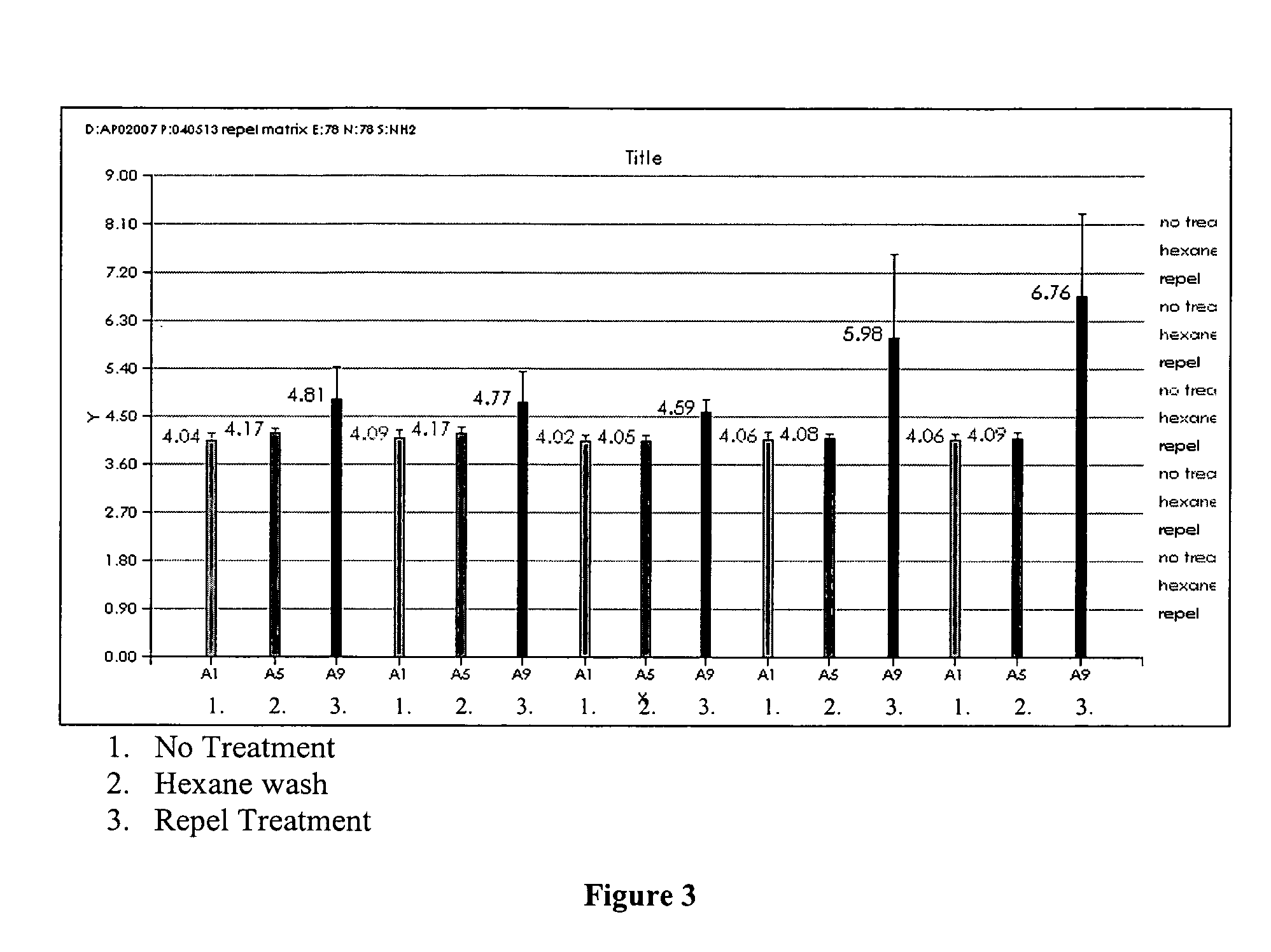Proteolipid membrane and lipid membrane biosensor
a biosensor and lipid membrane technology, applied in bioreactors/fermenters, biomass after-treatment, instruments, etc., can solve the problems of difficult assaying of lipids, affecting the structurally fragile environment, and labeling often perturbing, so as to achieve the effect of increasing the number of samples/readings
- Summary
- Abstract
- Description
- Claims
- Application Information
AI Technical Summary
Benefits of technology
Problems solved by technology
Method used
Image
Examples
example 1
Stable Hydrophobic Biosensor Surfaces
[0043] A stable hydrophobic colorimetric resonant biosensor surface can be prepared by injecting repel silane (Amersham Biosciences 17-1332-01) into wells comprising a colorimetric resonant biosensor TiO surface, for example a 96-well plate. Incubate for 7 minutes. Inject 90 ul hexane (anhydrous) (Sigma 227064) into each well. Aspirate 90ul of silane mixture with a multi-channel pipette. Inject 90 ul hexane (2nd injection) into wells. Aspirate 90 ul of silane mixture (2nd aspiration) with a multi-channel pipette. Inject 90 ul hexane (3rd injection) into wells. Aspirate all remaining solution in wells using an 8-channel stainless steel manifold connected to a vacuum pump. Allow the biosensor to cure in air after final aspiration. Wash the plate 2× with 100 μL PBS, then fill plate with 100 μL PBS. Sonicate the plate for 5-10 sec moving the plate back and forth in the sonication bath to disperse energy evenly across plate.
[0044] Dry the backside o...
example 2
Hydrophobic Silane Sensor Treatment Poly-Phe-Lys Deposition Test for Hydrophobicity
[0045]
TABLE 1Plate 1Plate 2Plate 3Plate 4Plate 5PPLShiftSD% CVShiftSD% CVShiftSD% CVShiftSD% CVShiftSD% CVNO4.00.13.54.10.13.44.00.13.34.10.13.34.10.12.9HEXANE4.20.12.54.20.12.94.00.12.84.10.12.54.10.12.8REPEL4.80.612.64.80.612.14.60.25.06.01.626.46.81.623.1
N for each reported number is 32 wells
[0046] A colorimetric resonant biosensor surface was treated with repel silane (2% w / v in octamethylcyclotetrasiloxane) by incubating 50 μl of repel silane for a 7 minute treatment in the wells of a microtiter biosensor plate. The silane solution was aspirated and the surface washed 3× with 90 μl of hexanes. The microtiter biosensor plate was cured for 5 minutes after final hexanes wash by allowing the plate to dry. The plate was washed 3× with PBS pH 7.4. PPL was deposited onto the silane treated biosensor surface. 40 μl of 0.1 mg / ml PPL in 10 mM sodium phosphate pH 9.05 was added to each 6mm diameter well o...
example 3
Repel Silane Treatment to Improve PPL Binding
[0053] A biosensor plate was O2 plasma treated prior to repel treatment. A 7 minute incubation of 50 μl repel silane treatment was performed in the 6 mm diameter wells of biosensor plates. The remaining silane was aspirated and the biosensor was washed 3× with 90 μl of hexane. The biosensor plate was cured for 5 minutes after the final hexane wash. The biosensor plate was washed 3× with PBS pH 7.4. 0.1 mg / ml PPL solutions were prepared in 10 mM NaH2PO3 buffers at pHs of 6.0, 7.4, 9.0, and 10.1, these buffers were prepared by adjusting an 11 mM NaH2PO3 pH 4.0 buffer with 1 M NaOH. 40 ml of the PPL solutions were added to the wells of the biosensor plate and dried overnight at RT. The biosensor plate was washed 3× with PBS. FIG. 6 shows the results of optimizing the hydrophobic coating to improve the capture of the model protein PPL.
PUM
| Property | Measurement | Unit |
|---|---|---|
| thickness | aaaaa | aaaaa |
| reflected wavelength | aaaaa | aaaaa |
| transmitted wavelength | aaaaa | aaaaa |
Abstract
Description
Claims
Application Information
 Login to View More
Login to View More - R&D
- Intellectual Property
- Life Sciences
- Materials
- Tech Scout
- Unparalleled Data Quality
- Higher Quality Content
- 60% Fewer Hallucinations
Browse by: Latest US Patents, China's latest patents, Technical Efficacy Thesaurus, Application Domain, Technology Topic, Popular Technical Reports.
© 2025 PatSnap. All rights reserved.Legal|Privacy policy|Modern Slavery Act Transparency Statement|Sitemap|About US| Contact US: help@patsnap.com



